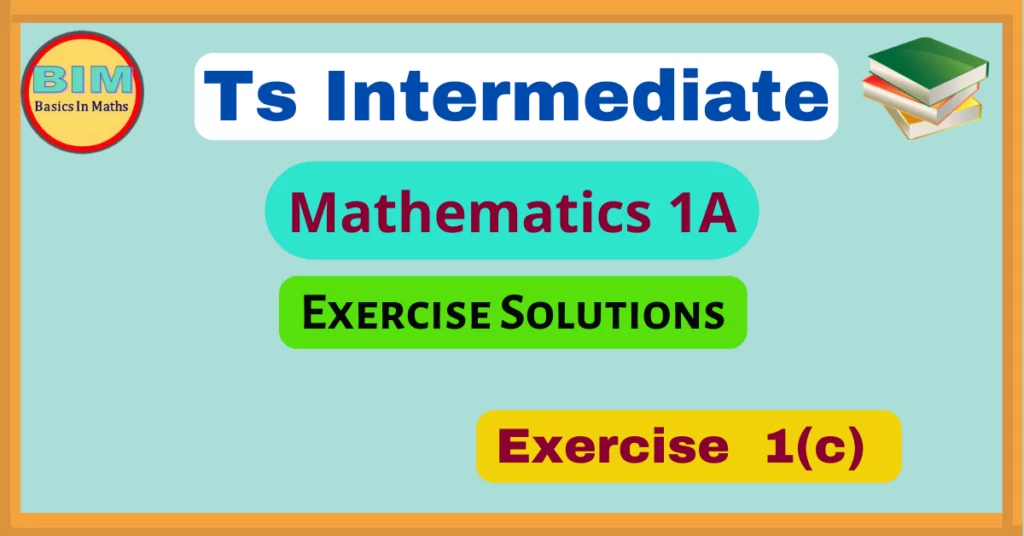Functions Exercise 1c Solutions
Functions Exercise 1c
The famous mathematician ” Lejeune Dirichlet” defined a function.
Function: A variable is a symbol which represents any one of a set of numbers, if two variables x and y so related that whenever a value is assigned to x there is autometically assigned by some rule or correspondence a value to y, then we say y is a function of x.
Chapter 1 Functions Exercise 1c Solutions for inter first year students, prepared by Mathematics expert of www.basicsinmaths.com
Functions Exercise 1c
I.
1.Find the domains of the following real valued functions
(i)
f (x) =![]()
given function is f (x) =![]()
f (x) is defined when (x2 – 1) (x + 3) ≠ 0
⟹ (x2 – 1) ≠ 0 or (x + 3) ≠ 0
⟹ (x + 1) (x – 1) ≠ 0 or (x + 3) ≠ 0
⟹ x ≠ 1, x ≠ – 1 or x ≠ – 3
∴ Domain of f(x) is R – {– 1, – 3, 1}
(ii)
f (x) = ![]()
Given function is f (x) = ![]()
f (x) is defined when (x – 1) (x – 2) (x – 3) ≠ 0
⟹ x ≠ 1, x ≠ 2 or x ≠ 3
∴ Domain of f(x) is R – {1, 2, 3}
(iii)
f (x) = ![]()
Given function is f (x) = ![]()
f (x) is defined when 2 – x > 0 and 2 – x ≠ 1
⟹ 2 > x and 2 – 1 ≠ x
⟹ 2 > x and x ≠ 1
∴ Domain of f(x) is (– ∞, 2) – {1}
(iv)
f (x) = ![]()
Given function is f (x) = ![]()
f (x) is defined when x ∈ R
∴ Domain of f(x) is R
Functions Exercise 1c
(v)
f (x) =![]()
Given function is f (x) = ![]()
f (x) is defined when 4x – x2 ≥ 0
⟹ x (4 – x) ≥ 0
⟹ x (x – 4) ≤ 0
⟹ (x – 0) (x – 4) ≤ 0
⟹ x ∈ [0, 4]
∴ Domain of f(x) is [0, 4]
(vi)
f (x) =![]()
Given function is f (x) =![]()
f (x) is defined when 1 – x2 > 0
⟹ x2 – 1 < 0
⟹ (x – 1) (x + 1) < 0
⟹ x ∈ (– 1, 1)
∴ Domain of f(x) is (– 1, 1)
(vii)
f (x) =![]()
Given function is f (x) = ![]()
f (x) is defined when x + 1≠ 0
⟹ x ≠ – 1
∴ Domain of f(x) is R – {– 1}
(viii)
f(x) =![]()
Given function is f (x) =![]()
f (x) is defined when x2 – 25 ≥ 0
⟹ (x – 5) (x + 5) ≥ 0
⟹ x ∈ (–∞, –5] ∪ [5, ∞)
![]()
⟹ x ∈ R – (– 5, 5)
∴ Domain of f(x) is R – (– 5, 5)
Functions Exercise 1c
(ix)
f(x) = ![]()
Given function is f (x) = ![]()
f (x) is defined when x – [x] ≥ 0
⟹ x ≥ [x]
⟹ x ∈ R
∴ Domain of f(x) is R
(x)
f(x) =![]()
Given function is f (x) =![]()
f (x) is defined when [x] – x ≥ 0
⟹ [x] ≥ x
⟹ x ∈ Z
∴ Domain of f(x) is Z
Functions Exercise 1c
2. find the ranges of the following real valued functions
(i)
f(x) =![]()
Given function is f (x) = ![]()
Let y = ![]()
⟹ |4 – x2| = ey
∵ ey > 0 ∀ y ∈ R
∴ Range of f(x) is R
(ii)
f(x) =![]()
Given function is f (x) =![]()
f (x) is defined when [x] – x ≥ 0
⟹ [x] ≥ x
⟹ x ∈ Z
Domain of f(x) is Z
Range of f = {0}
(iii)
f(x) =
Given function is f (x) =
f (x) is defined when x ∈ R
Domain of f(x) is R
For x ∈ R [x] is an integer
Since sin nπ = 0, ∀ n ∈ z
⟹ sin π[x] = 0
∴ Range of f = {0}
(iv)
f (x) =![]()
Given function is f (x) = ![]()
f (x) is defined when x – 2 ≠ 0
⟹ x ≠ 2
Domain of f(x) is R – {2}
Let y = ![]()
=![]()
= x + 2
If x = 2 ⟹ y = 2 + 2 = 4
∴ Range of f(x) is R – {4}
Functions Exercise 1c
(v)
f (x) =![]()
let y =![]()
y2 = 9 + x2
x2 = y2 – 9
x = ![]()
it is defined when y2 – 9 ≥ 0
⟹ (y – 3) (y + 3) ≥ 0
y ∈ (– ∞, – 3] ∪ [3, ∞)
but y = ![]() ≥ 0
≥ 0
∴ Range of f(x) is [3, ∞)
3. If f and g are real valued functions f(x) = 2x – 1 ang g (x) = x2 then
find
Sol:
Given f and g are real valued functions f(x) = 2x – 1 ang g (x) = x2
(i)
(3f – 2g) (x) = 3 f(x) – 2g (x)
= 3 (2x – 1) – 2(x2)
= 6x – 3 – 2x2
= – 2x2 + 6x – 3
∴ (3f – 2g) (x) =– 2x2 + 6x – 3
(ii)
(fg) (x) = f (x) g (x)
= (2x – 1) (x2)
= 2x3 + x2
∴ (fg) (x) = 2x3 + x2
(iii)

4. If f = {(1, 2), (2, – 3) (3, – 1)} then find (i) 2f (ii) (fog) 2 + f iii) f2 (iv) 
Sol:
Given f = {(1, 2), (2, – 3) (3, – 1)}
(i)
(2f) (1) = 2 f (1) = 2 × 2 = 4
(2f) (2) = 2 f (2) = 2 × – 3 = – 6
(2f) (3) = 2 f (3) = 2 × – 1 = – 2
∴ 2f = {(1, 4), (2, – 6) (3, – 2)}
(ii)
(2 + f) (1) = 2 + f (1) = 2 + 2 = 4
(2 + f) (2) = 2 + f (2) = 2 + (– 3) = – 1
(2 + f) (3) = 2 + f (3) = 2 + (– 1) = 1
∴ 2 + f = {(1, 4), (2, – 1) (3, 1)}
(iii)
(f2) (1) = [f (1))]2 = 22 = 4
(f2) (2) = [f (2))]2 = (– 3)2 = 9
(f2) (3) = [f (1))]2 = (– 1)2 = 1
∴ f2= {(1, 4), (2, 9) (3, 1)}
(iv)

II.
1.Find the domain of the following real valued functions
(i)
f (x) = ![]()
f(x) is defined when x2 – 3x + 2 ≥ 0
x2 – 2x – x + 2 ≥ 0
x (x – 2) – 1(x – 2) ≥ 0
(x – 1) (x – 2) ≥ 0
x ∈ (– ∞, 1] ∪ [2, ∞)
∴ Domain of f(x) is R – (1, 2)
(ii)
f(x) = log (x2 – 4x + 3)
f(x) is defined when x2 – 4x + 3 > 0
x2 – 3x – x + 3 > 0
x (x – 3) – 1(x – 3) > 0
(x – 1) (x – 3) > 0
x ∈ (– ∞, 1) ∪ (3, ∞)
∴ Domain of f(x) is R – [1, 3]
(iii)
f(x) =![]()
f(x) is defined when 2 + x ≥ 0, 2 – x ≥ 0 and x ≠ 0
x ≥ – 2, x ≤ 2 and x ≠ 0
– 2 ≤ x ≤ 2 and x ≠ 0
x ∈ [–2, 2] – {0}
∴ Domain of f(x) is [–2, 2] – {0}
(iv)
f(x) =
f(x) is defined in two cases as follows:
case (i) 4 – x2 ≥ 0 and [x] + 2 > 0
x2 – 4 ≤ 0 and [x] > –2
(x – 2) (x + 2) ≤ 0 and [x] > –2
x ∈ [– 2, 2] and x ∈ [– 1, ∞)
x ∈ [– 1, 2]
case (ii) 4 – x2 ≤ 0 and [x] + 2 < 0
x2 – 4 ≥ 0 and [x] < –2
(x – 2) (x + 2) ≥ 0 and [x] < –2
x ∈ (– ∞, –2] ∪ [2, ∞) and x ∈ (–∞, –2)
x ∈ (–∞, –2)
from case (i) and case (ii)
x ∈ (–∞, –2) ∪ [– 1, 2]
∴ Domain of f(x) is (–∞, –2) ∪ [– 1, 2]
(v)
f(x) = ![]()
f(x) is defined when ![]() ≥ 0 and x – x2 > o
≥ 0 and x – x2 > o
x – x2 ≥ (0.3)0 and x2 – x < 0
x – x2 ≥ 1 and x (x – 1) < 0
x2 –x + 1 ≤ 0 and (x – 0) (x – 1) < 0
it is true for all x ∈ R and x ∈ (0, 1)
∴ domain of f(x) = R∩ (0, 1) = (0, 1)
(vi)
f(x) =![]()
f(x) is defined when x +|x| ≠ 0
|x| ≠ – x
|x| ≠ – x
⟹|x| = x
⟹ x > 0
x ∈ (0, ∞)
∴ Domain of f(x) is (0, ∞)
2. Prove that the real valued function  is an even function
is an even function
Sol:
Given f(x) = ![]()


3. Find the domain and range of the following functions
(i)
f (x) = ![]()
Given f(x) =![]()
Since [x] is an integer
sin π[x] = tan π[x] = 0 ∀ x ∈ R
∴ domain of f(x) is R
and
since tan π[x] = 0
Range of f(x) = {0}
(ii)
f(x) = ![]()
Given f (x) = ![]()
It is defined when 2 – 3x ≠ 0
⟹ 2 ≠ 3x
⟹ x ≠ 2/3
∴ Domain of f (x) = R – {2/3}
Let y = f(x)
y =![]()
⟹ y (2 – 3x) = x
2y – 3xy = x
2y = x + 3xy
2y = x (1 + 3y)
⟹ x = ![]()
It is defined when 1 + 3y ≠ 0
1 ≠ –3y
y ≠ – 1/3
∴ Range of f (x) = R – {– 1/3}
(iii)
f(x) = |x| + | 1 + x|
Given function is f (x) = |x| + |1 + x|
f (x) is defined for all x ∈ R
∴ domain of f(x) = R

f (– 3) = |– 3| + |1 – 3|
=|– 3| + |– 2|
= 3 + 2 = 5
f (– 2) = |– 2| + |1 – 2|
=|– 2| + |– 1|
= 2 + 1 = 3
f (– 1) = |– 1| + |1 – 1|
=|– 1| + |0|
= 1 + 0 = 1
f (0) = |0| + |1 + 0| = 1
f (1) = |1| + |1 + 1|
= 1 + |2|
= 1 + 2 = 3
f (2) = |2| + |1 + 2|
= |2| + |3|
= 2 + 3 = 5
f (3) = |3| + |1 + 3|
= |3| + |4|
= 3 + 4 = 7
∴ Range of f(x) = [1, ∞)


 is an even function
is an even function

